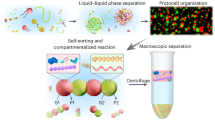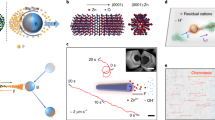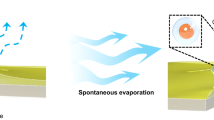Abstract
The spontaneous assembly of micro-compartmentalized colloidal objects capable of controlled interactions offers a step towards rudimentary forms of collective behaviour in communities of artificial cell-like entities (synthetic protocells). Here we report a primitive form of artificial phagocytosis in a binary community of synthetic protocells in which multiple silica colloidosomes are selectively ingested by self-propelled magnetic Pickering emulsion (MPE) droplets comprising particle-free fatty acid-stabilized apertures. Engulfment of the colloidosomes enables selective delivery and release of water-soluble payloads, and can be coupled to enzyme activity within the MPE droplets. Our results highlight opportunities for the development of new materials based on consortia of colloidal objects, and provide a novel microscale engineering approach to inducing higher-order behaviour in mixed populations of synthetic protocells.
This is a preview of subscription content, access via your institution
Access options
Access Nature and 54 other Nature Portfolio journals
Get Nature+, our best-value online-access subscription
$29.99 / 30 days
cancel any time
Subscribe to this journal
Receive 12 print issues and online access
$259.00 per year
only $21.58 per issue
Buy this article
- Purchase on Springer Link
- Instant access to full article PDF
Prices may be subject to local taxes which are calculated during checkout




Similar content being viewed by others
References
Tu, Y. et al. Mimicking the cell: bio-inspired functions of supramolecular assemblies. Chem. Rev. 116, 2023–2078 (2016).
Li, M., Huang, X., Tang, T.-Y. D. & Mann, S. Synthetic cellularity based on non-lipid micro-compartments and protocell models. Curr. Opin. Chem. Biol. 22, 1–11 (2014).
Schoonen, L. & van Hest, J. C. M. Compartmentalization approaches in soft matter science: from nanoreactor development to organelle mimics. Adv. Mater. 28, 1109–1128 (2015).
Kelly, B. T., Baret, J. C., Taly, V. & Griffiths, A. D. Miniaturizing chemistry and biology in microdroplets. Chem. Commun. 1773–1788 (2007).
Mann, S. The origins of life: old problems, new chemistries. Angew. Chem. Int. Ed. Engl. 52, 155–162 (2013).
Li, M., Green, D. C., Anderson, J. L. R., Binks, B. P. & Mann, S. In vitro gene expression and enzyme catalysis in bio-inorganic protocells. Chem. Sci. 2, 1739–1745 (2011).
Li, M., Huang, X. & Mann, S. Spontaneous growth and division in self-reproducing inorganic colloidosomes. Small 10, 3291–3298 (2014).
Li, M., Harbron, R. L., Weaver, J. V. M., Binks, B. P. & Mann, S. Electrostatically gated membrane permeability in inorganic protocells. Nat. Chem. 5, 529–536 (2013).
Pagonabarraga, I. Wetting dynamics: adsorbed colloids relax slowly. Nat. Mater. 11, 99–100 (2012).
Tang, J., Quinlan, P. J. & Tam, K. C. Stimuli-responsive Pickering emulsions: recent advances and potential applications. Soft Matter 11, 3512–3529 (2015).
Dinsmore, D. et al. Colloidosomes: selectively permeable capsules composed of colloidal particles. Science 298, 1006–1009 (2002).
Li, Y. et al. Magnetic hydrogels and their potential biomedical applications. Adv. Funct. Mater. 23, 660–672 (2013).
Wu, C., Bai, S., Ansorge-Schumacher, M. B. & Wang, D. Nanoparticle cages for enzyme catalysis in organic media. Adv. Mater. 23, 5694–5699 (2011).
Akkarachaneeyakorn, K., Li, M., Davis, S. A. & Mann, S. Secretion and reversible assembly of extracellular-like matrix by enzyme-active colloidosome-based protocells. Langmuir 32, 2912–2919 (2016).
Sun, S. et al. Chemical signalling and functional activation in colloidosome-based protocells. Small 12, 1920–1927 (2016).
Nourian, Z. & Danelon, C. Linking genotype and phenotype in protein synthesizing liposomes with external supply of resources. ACS Synth. Biol. 2, 186–193 (2013).
Martini, L. & Mansy, S. S. Cell-like systems with riboswitch controlled gene expression. Chem. Commun. 47, 10734–10736 (2011).
Peters, R. J. R. W. et al. Cascade reactions in multicompartmentalized polymersomes. Angew. Chem. Int. Ed. 53, 146–150 (2014).
Chandrawati, R. & Caruso, F. Biomimetic liposome- and polymersome-based multicompartmentalized assemblies. Langmuir 28, 13798–13807 (2012).
Tawfik, D. S. & Griffiths, A. D. Man-made cell-like compartments for molecular evolution. Nat. Biotech. 16, 652–656 (1998).
Huang, X., Patil, A. J., Li, M. & Mann, S. Design and construction of higher-order structure and function in proteinosome-based protocells. J. Am. Chem. Soc. 136, 9225–9234 (2014).
Huang, X. et al. Interfacial assembly of protein–polymer nano-conjugates into stimulus-responsive biomimetic protocells. Nat. Commun. 4, 2239 (2013).
Koga, S., Williams, D. S., Perriman, A. W. & Mann, S. Peptide-nucleotide microdroplets as a step towards a membrane-free protocell model. Nat. Chem. 3, 720–724 (2011).
Tang, T.-Y. D. et al. Fatty acid membrane assembly on coacervate microdroplets as a step towards a hybrid protocell model. Nat. Chem. 6, 527–533 (2014).
Rollie, S., Mangold, M. & Sundmacher, K. Designing biological systems: systems engineering meets synthetic biology. Chem. Eng. Sci. 69, 1–29 (2012).
Qiao, Y., Li, M., Booth, R. & Mann, S. Predatory behaviour in synthetic protocell communities. Nat. Chem. 9, 110–119 (2017).
Schwarz-Schilling, M., Aufinger, L., Muckl, A. & Simmel, F. C. Chemical communication between bacteria and cell-free gene expression systems within linear chains of emulsion droplets. Integr. Biol. 8, 564–570 (2016).
Weitz, M. et al. Diversity in the dynamical behaviour of a compartmentalized programmable biochemical oscillator. Nat. Chem. 6, 295–302 (2014).
Bekki, S., Vignes-Adler, M., Nakache, E. & Adler, P. M. Solutal Marangoni effect. J. Colloid. Interface Sci. 140, 492–506 (1990).
Toyota, T., Maru, N., Hanczyc, M. M., Ikegami, T. & Sugawara, T. Self-propelled oil droplets consuming “fuel” surfactant. J. Am. Chem. Soc. 131, 5012–5013 (2009).
Hanczyc, M. M., Toyota, T., Ikegami, T., Packard, N. & Sugawara, T. Fatty acid chemistry at the oil-water interface: self-propelled oil droplets. J. Am. Chem. Soc. 129, 9386–9391 (2007).
Ban, T., Yamagami, T., Nakata, H. & Okano, Y. pH-dependent motion of self-propelled droplets due to Marangoni effect at neutral pH. Langmuir 29, 2554–2561 (2013).
Nightingale, A. M., Phillips, T. W., Bannock, J. H. & de Mello, J. C. Controlled multistep synthesis in a three-phase droplet reactor. Nat. Commun. 5, 3777 (2014).
Moya-Ramírez, I., García-Román, M. & Fernández-Arteaga, A. Waste frying oil hydrolysis in a reverse micellar system. ACS Sustain. Chem. Eng. 4, 1025–1031 (2016).
Acknowledgements
We thank the European Union’s Horizon 2020 research and innovation programme for funding the work under Marie Skłodowska-Curie grant agreement, no. 656490, A. Patil for fruitful discussions, L. Powell for help with magnetite particle synthesis and MPE droplet preparation, and the Krüss Facility and Electron Microscopy Unit (School of Chemistry, University of Bristol) for assistance with contact angle/interfacial tension measurements and SEM imaging, respectively.
Author information
Authors and Affiliations
Contributions
L.R.-A., M.L. and S.M. conceived the experiments; L.R.-A. performed the experiments; L.R.-A. and M.L. undertook the data analysis; L.R.-A., M.L. and S.M. wrote the manuscript.
Corresponding author
Ethics declarations
Competing interests
The authors declare no competing financial interests.
Supplementary information
Supplementary Information
Supplementary Information (PDF 763 kb)
Supplementary Information
Supplementary movie 1 (MP4 28268 kb)
Supplementary Information
Supplementary movie 2 (MP4 29554 kb)
Supplementary Information
Supplementary movie 3 (MP4 26446 kb)
Supplementary Information
Supplementary movie 4 (MP4 22374 kb)
Supplementary Information
Supplementary movie 5 (MP4 56307 kb)
Supplementary Information
Supplementary movie 6 (MP4 40402 kb)
Supplementary Information
Supplementary movie 7 (MP4 30410 kb)
Supplementary Information
Supplementary movie 8 (MP4 17620 kb)
Supplementary Information
Supplementary movie 9 (MP4 11440 kb)
Rights and permissions
About this article
Cite this article
Rodríguez-Arco, L., Li, M. & Mann, S. Phagocytosis-inspired behaviour in synthetic protocell communities of compartmentalized colloidal objects. Nature Mater 16, 857–863 (2017). https://doi.org/10.1038/nmat4916
Received:
Accepted:
Published:
Issue Date:
DOI: https://doi.org/10.1038/nmat4916
This article is cited by
-
Superstructural ordering in self-sorting coacervate-based protocell networks
Nature Chemistry (2024)
-
Photoswitchable gating of non-equilibrium enzymatic feedback in chemically communicating polymersome nanoreactors
Nature Chemistry (2023)
-
A three-tiered colloidosomal microreactor for continuous flow catalysis
Nature Communications (2021)
-
Chemical-mediated translocation in protocell-based microactuators
Nature Chemistry (2021)
-
Transmembrane transport in inorganic colloidal cell-mimics
Nature (2021)



